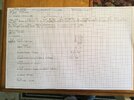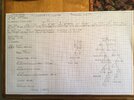Session 7 November 1998
Q: Okay, let’s move on.
(A) You mentioned the term ‘pyramidal’ and I thought about putting prime numbers along a pyramid, around, higher and higher, but then, today, we discovered that Ulam was putting prime numbers along a spiral and there were funny patterns arising. So, I thought that maybe we should do something similar, but three dimensional rather than two. Is this the right track?
A: In prime numbers, you will find resonance.
Q: Resonance in prime numbers? Can you please elaborate a little bit on that?
A: Elaboration is not needed because the answers are there for you already in the texts, as with so much else. One needs only listen to the “music to your ears.”
Q: Why didn’t you answer my question about putting prime numbers around a pyramid?
A: Mathematics converts to sound in geometric measurements. Why do you think the pyramid became a pyramid?
Q: (A) It became a pyramid because it is a simple shape to build.
(L) Did it become a pyramid because a sound shaped it? Determined its shape?
A: Closer.
Q: (L) And, what was the origin of this sound?
A: Those who heard it knew.
Q: (L) Who were those who heard it?
A: Those who knew how to convert math to sound. Why would the mystics reside there? Yahoo!
Q: (A) Somehow I have problems with following your clues, and I really don’t know what is my problem...
A: The problem is impatience with the digestion phase.
Q: (A) How long can a digestion phase last? We don’t have much time!
A: However long it takes. And who says you do not have much “time?” Answer, mi Arkady, answer!!
Q: (A) Well, I agree that I am impatient. But, the point is that I feel that if I would have a little bit more of a clue, I could do much more, and for now...
A: Our words sing to you. Let them ring.
Q: (A) What is the difference between singing and ringing?
(L) I don’t think that’s the point.
(A) Ring is to awake? Probably. You mean I am not taking your words seriously enough?
A: No. We meant to let it sink in rejoice. Exult!
Q: (L) Would it help...
A: Listen to Ludwig’s 9th. Combine with the prime numbers, and what do you have?
Q: (L) Hmmm... musical notation that relates to prime numbers?
A: Why not bring the ninth in here now for inspiration?!? [We put the ninth on and crank up the volume so that it can be heard.]
Q: (L) Okay, now we can hear it, but not too loudly.
A: That is good.
Q: (L) Now my question is: if you translate numbers into musical sequence or notation, does this accomplish the deed?
A: You are certainly on your way!
Q: (A) What can I do as a mathematician, or what SHOULD I do?
A: Let the pathway lead you. It has not yet failed Lolly. [Laughter at the use of Laura’s nickname.] So you insinuate failure for yourself? Tsk tsk, my boy. Faith in this enterprise takes one places. Look where it has taken you so far!!



